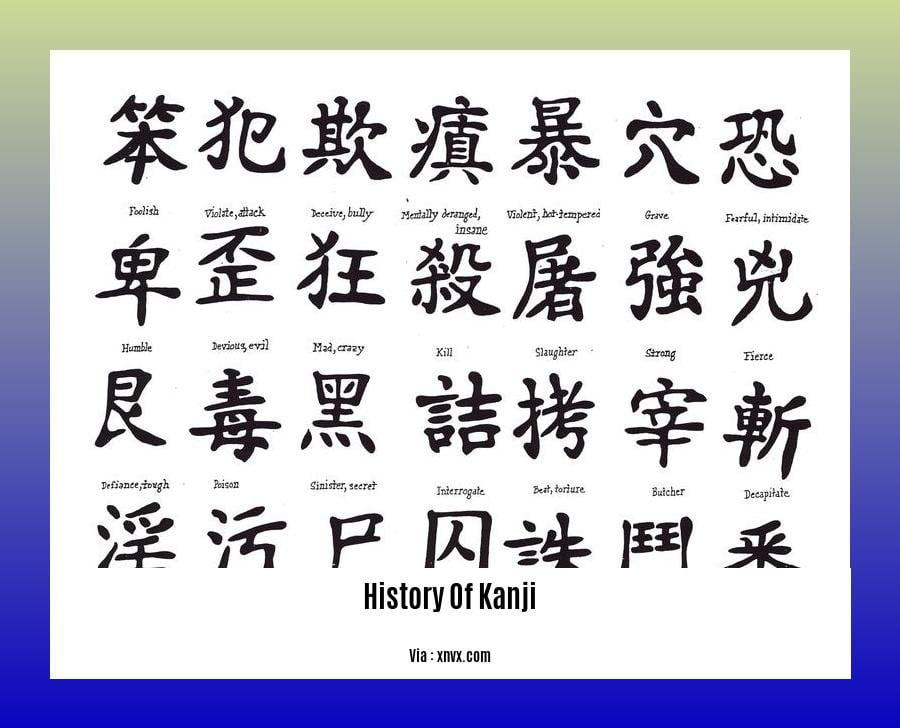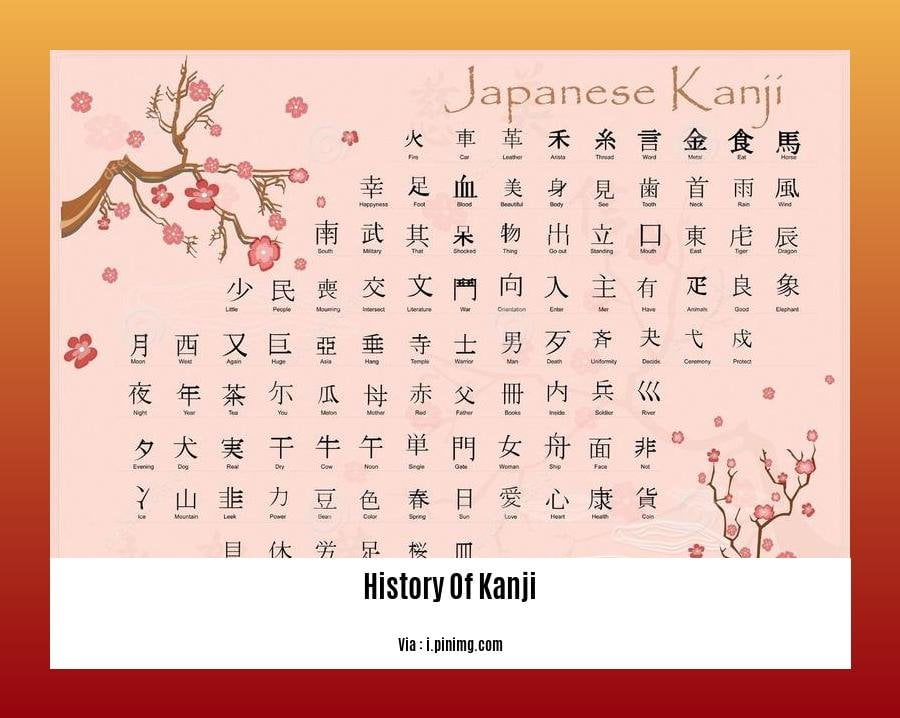Welcome to an illuminating journey through the history of Kanji, the intricate writing system that has shaped East Asian languages and cultures for millennia. In [Decoding the History of Kanji: A Journey Through the Evolution of East Asian Writing], we’ll embark on a captivating exploration of the roots, evolution, and profound impact of these remarkable characters.
Key Takeaways:
Kanji is a writing system using Chinese characters to represent Japanese.
Kanji’s origins can be traced to China, and it arrived in Japan through the Korean Peninsula.
Kanji has evolved from pictographic symbols to the modern-day characters used today.
In Japanese, kanji is primarily used to write nouns, verb roots, adjectives, and other content words.
History of Kanji

Kanji, an intricate writing system, is deeply imbued with history, holding a prominent place in the evolution of East Asian languages and cultures. This article takes you on a captivating journey through the annals of the history of kanji, shedding light on its origins, transformative journey, and profound impact on the written word in East Asia.
Kanji’s Chinese Roots
Our adventure begins in China, the birthplace of Kanji. These characters emerged as pictographic symbols, capturing the essence of objects and ideas through simple drawings. Over time, these symbols evolved, becoming more abstract and versatile, forming the foundation of the Chinese writing system.
Embracing Kanji in Japan
In the 5th century, Kanji crossed the sea to Japan, a defining moment in the evolution of the language. The Japanese adapted these characters to express their own language, infusing them with new meanings and pronunciations. This intricate dance between two distinct languages gave rise to a unique system, blending Chinese characters with indigenous Japanese elements.
Kanji’s Enduring Influence
Kanji has left an indelible mark on East Asia’s cultural landscape. It serves as a powerful tool for recording history, literature, and philosophy. Kanji’s distinct characters have also influenced the development of art and calligraphy, contributing to the region’s rich artistic traditions.
Kanji and Japanese Language
In modern Japanese, Kanji serves as the backbone of the written language. Used alongside two phonetic scripts, Hiragana and Katakana, Kanji brings depth, nuance, and precision to the written word. This fusion of systems allows Japanese to express a wide range of ideas and emotions.
Learning Kanji: A Journey of Discovery
Embarking on the journey of learning Kanji can be both challenging and rewarding. Each character holds a story, a window into East Asia’s past. With persistence and curiosity, you’ll unravel the intricacies of this writing system, unlocking a deeper understanding of the region’s history and culture.
Remember, Kanji is not merely a collection of characters; it’s a living legacy, evolving alongside the languages and cultures it represents. Embrace the adventure of learning Kanji, and discover the hidden treasures of East Asia’s written heritage.
Explore the annals of Kalyan’s rich history, dating back centuries, and uncover the stories that shaped this vibrant city. history of kalyan
Delve into the chronicles of Kalyan City, a captivating tapestry woven with tales of its founding, growth, and transformation into a bustling metropolis. history of kalyan city
Embark on a journey through time as you discover the history of Kendriya Vidyalaya, an educational institution that has played a pivotal role in shaping the lives of countless students across India. history of kendriya vidyalaya
Witness the evolution of Kendriya Vidyalaya Sangathan, the governing body that oversees a network of schools dedicated to providing quality education to children of transferable Central Government employees. history of kendriya vidyalaya sangathan
Cultural Significance: Exploring the role of Kanji in East Asian societies, art, and literature

In Japan, Kanji is deeply embedded in the tapestry of culture and identity. Beyond its functional role in written language, Kanji characters hold profound cultural significance, reflecting the country’s rich heritage and interaction with East Asia.
Let’s explore the diverse ways in which Kanji has influenced and shaped East Asian societies, art, and literature:
1. Symbolism and Meaning:
Kanji characters often carry rich symbolic meanings, conveying ideas or concepts that go beyond their literal definitions. For example, the character for “home” (家) evokes a sense of warmth, family, and belonging.
This symbolism extends to cultural expressions, including traditional Japanese tea ceremonies, where specific Kanji are used to represent the desired atmosphere or sentiment.
2. Artistic Expression:
Kanji’s visual complexity and aesthetic qualities have made it a popular medium for artistic expression, particularly in calligraphy.
Japanese calligraphy, or Shodo, elevates Kanji beyond mere written characters, transforming them into graceful and expressive works of art.
3. Literature and Poetry:
Kanji’s rich vocabulary and ability to capture nuances of meaning have made it an indispensable tool for Japanese literature and poetry.
Renowned Japanese authors, such as Murasaki Shikibu and Matsuo Bashō, masterfully employed Kanji to create vivid imagery and convey deep emotions.
4. East Asian Interconnections:
The presence of Kanji in Japanese serves as a testament to Japan’s historical and cultural ties with China and other East Asian nations.
Shared Kanji characters facilitate communication and understanding across cultures, fostering a sense of unity and identity within the East Asian region.
5. Modernization and Globalization:
In the modern era, Kanji has played a crucial role in Japan’s modernization and globalization efforts.
The ability to incorporate foreign words and concepts using Kanji has allowed Japan to adapt to a rapidly changing world while preserving its cultural heritage.
Key Takeaways:
Kanji holds profound cultural significance in East Asian societies, representing rich symbolism and conveying deep meanings.
Kanji’s aesthetic qualities have made it a popular medium for artistic expression, particularly in the form of calligraphy.
Kanji’s role in literature and poetry allows authors to create vivid imagery and convey nuanced emotions.
The presence of Kanji in Japanese serves as a testament to Japan’s historical and cultural ties with other East Asian nations.
Kanji has been instrumental in Japan’s modernization and globalization efforts, enabling the incorporation of foreign words and concepts while preserving cultural heritage.
Relevant URLs:
[1] https://www.tofugu.com/japanese/kanji-history/
[2]
Linguistic Impact: Examining the influence of Kanji on the development of East Asian languages
Kanji, a system of writing that initially emerged in China, has left an indelible mark on the linguistic landscape of East Asia. Its intricate characters, each carrying a profound meaning, have influenced the development of East Asian languages in numerous ways. Let’s embark on a journey to unravel the linguistic impact of Kanji.
A Bridge Across Languages
Kanji acted as a bridge, connecting diverse East Asian languages and enabling the exchange of ideas, knowledge, and culture. As Kanji characters traveled from China to Japan, Korea, and beyond, they carried with them their semantic and phonetic essence, becoming a common ground for communication and understanding.
Enriching Vocabulary and Expression
The adoption of Kanji significantly enriched the vocabulary of East Asian languages. With each character representing a specific concept or object, Kanji allowed for the expression of complex ideas in a concise and efficient manner. This linguistic expansion facilitated the development of sophisticated literature, philosophy, and scientific discourse.
Preserving Cultural Heritage
Kanji served as a guardian of cultural heritage, preserving ancient texts, historical records, and literary works. It provided a tangible link to the past, allowing future generations to access and comprehend the wisdom and knowledge of their ancestors. Through Kanji, the cultural heritage of East Asia was meticulously documented and passed down, ensuring its continuity and longevity.
A Catalyst for Literacy and Education
The introduction of Kanji spurred the development of literacy and education in East Asian societies. The need to master these complex characters encouraged the establishment of educational systems and the cultivation of a literate population. This widespread literacy played a crucial role in the advancement of knowledge and the dissemination of information, fostering intellectual and cultural growth.
Key Takeaways:
Kanji acted as a bridge, facilitating communication and understanding across diverse East Asian languages.
It enriched the vocabulary and expressive capabilities of East Asian languages, enabling the articulation of complex ideas.
Kanji served as a guardian of cultural heritage, preserving ancient texts and ensuring the continuity of cultural traditions.
The adoption of Kanji catalyzed the development of literacy and education, fostering intellectual and cultural growth in East Asian societies.
Sources:
[1] Journal of East Asian Linguistics:
[2] Chinese, Japanese, and Korean Writing Systems: All East-Asian but Diversified:
Contemporary Use: Discussing the ongoing relevance and challenges of Kanji in modern society
In the tapestry of languages, Kanji stands out as an enduring symbol of East Asia’s rich cultural heritage. Its intricate characters, each a brushstroke of history, continue to play a vital role in the contemporary landscape of Japan, China, and beyond.
Relevance of Kanji in Modern Society
Kanji’s relevance in modern society is undeniable. It remains the backbone of the Japanese written language, coexisting harmoniously with the phonetic scripts hiragana and katakana to create a rich and nuanced writing system. Kanji characters add depth and precision to the written word, enabling the expression of complex ideas and emotions that would be difficult to convey with phonetic characters alone.
Challenges of Kanji in Modern Society
However, the use of Kanji in modern society is not without its challenges. In an increasingly globalized world, where communication often transcends linguistic borders, the complexity of Kanji can be a barrier to effective communication. The sheer number of characters, each with its unique meaning and pronunciation, can be daunting for non-native speakers and can hinder the accessibility of information for a wider global audience.
Balancing Tradition and Modernization
The ongoing relevance of Kanji in modern society requires a delicate balance between preserving its cultural heritage and adapting to the demands of a rapidly changing world. Efforts to simplify Kanji characters and reduce their number have been undertaken to make the language more accessible to non-native speakers. However, such initiatives must tread carefully, ensuring that the integrity and essence of Kanji are not compromised in the process.
Conclusion: Kanji’s Enduring Legacy
As we peer into the future, it is clear that Kanji’s legacy will continue to shape the cultural and linguistic landscape of East Asia. Its enduring relevance, despite the challenges it faces, is a testament to its deep-rooted significance in the region. Whether as a symbol of cultural heritage or a tool for modern communication, Kanji’s journey is far from over, and its impact on East Asian societies will undoubtedly endure for generations to come.
Key Takeaways:
Kanji remains essential in the Japanese written language, adding depth and precision to the written word.
The complexity of Kanji poses challenges in a globalized world, hindering accessibility for non-native speakers.
Balancing tradition and modernization is crucial to ensure Kanji’s continued relevance while adapting to the demands of a changing world.
Efforts to simplify Kanji characters aim to make the language more accessible while preserving its integrity and essence.
Kanji’s enduring legacy will continue to shape East Asia’s cultural and linguistic landscape for generations to come.
Relevant URLs:
The Japanese Writing System: Challenges and Opportunities
Studying How To Study Kanji: A Practical Approach
FAQ
Q1. What is the origin of Kanji?
A1. Kanji originated in China as a system of writing using Chinese characters and was introduced to Japan in the 5th century via the Korean Peninsula.
Q2. How did Kanji evolve over time?
A2. Kanji evolved from pictographic symbols representing objects and ideas to modern-day characters with phonetic and semantic components, reflecting the changing needs of the Japanese language.
Q3. What role did Kanji play in the development of Japanese language and culture?
A3. Kanji had a profound impact on Japanese language and culture, influencing literature, art, and society by providing a means to express complex ideas and integrating foreign words and concepts.
Q4. How does Kanji differ from other writing systems used in Japan, such as hiragana and katakana?
A4. Kanji, adopted from Chinese characters, is a logographic system representing words or morphemes, while hiragana and katakana are syllabaries, each symbol representing a Japanese sound.
Q5. Why is Kanji still important in modern Japanese society?
A5. Kanji continues to be an essential part of Japanese culture, used in various contexts, including newspapers, magazines, books, and websites, enabling the expression of complex ideas and preserving the country’s rich history and interaction with East Asian cultures.
- Guatemala vs. Costa Rica: Plan Your Trip Smartly - April 16, 2025
- Master Types of Pumps: Ultimate Guide to Selection - April 16, 2025
- Unlock Types of Makeup Secrets: Master Any Look Now - April 16, 2025
















